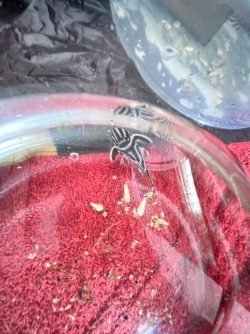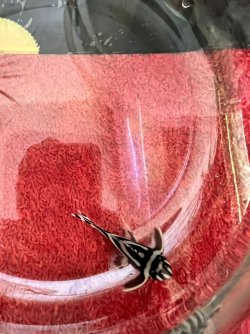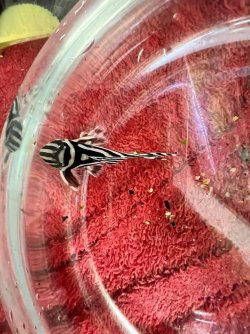This is a best guess as the only way I can reliably sex plecos is by venting them. I know some real pros who make mistakes when sexing solely by body/fin shape. As best as I can tell you have two females and 5 males. The 3rd fish in the top row and the 1st in the second row look, to me, to be females and the rest males. But I would not stake my life on this call.
The ideal ratio is 2m/1fm. The reason being that a females can produce eggs about every two weeks but a male needs about a month from spawning to booting the kids from the cave. This means there are three ways to set up to breed zebras or some of the other B&W Hypans from the Big Bend of the Rio Xingu.
One way is to do pairs, another is to do reverse trios and the final is to work with groups. I only do the latter. Each of these methods has it's own advantages and disadvantages.
Btw, the biggest disadvantage of groups is that normally not all the fish spawn. Subordinate females may try to sneak into a cave with eggs or wigglers in it if the dad slips out for a bite to eat. She will then enter his cave and eat the contents. Then, because he has no offspring to tend, he is prepared to spawn again. This happens occasionally but the more fish one has and the smaller the space, the greater the odds become this could happen.
Also, in a group there will be pecking orders established for both the male and female populations. This can involve a light of fighting and you can tell this by seeing white scrapes on the sides of the fish. This is also common in breeding as well, but moreso in pecking order issues. Once that order is established, adding or removing fish disrupts the order and they may start over with the fighting to reestablish the order. When this happens, it normally also stops spawning until things are worked out.
When I bought my breeding group of zebras in 06, the person helping me warned me not to mix the two zebras I had with the new groups for the above reasons. I listened and I got my first spawn abiut two weeks after I got the group of zebras.
 A3CF740C-8BD7-44C5-984E-AA4545D6DF80.jpeg329.1 KB · Views: 32
A3CF740C-8BD7-44C5-984E-AA4545D6DF80.jpeg329.1 KB · Views: 32 636BD68F-A799-4A92-A808-EA1D86369B5E.jpeg107 KB · Views: 30
636BD68F-A799-4A92-A808-EA1D86369B5E.jpeg107 KB · Views: 30 A253C27D-FA99-44DE-A934-95AF5E7100BA.jpeg166.3 KB · Views: 30
A253C27D-FA99-44DE-A934-95AF5E7100BA.jpeg166.3 KB · Views: 30 330A3543-B3C5-4D43-9B00-40D2B69F1736.jpeg125.3 KB · Views: 32
330A3543-B3C5-4D43-9B00-40D2B69F1736.jpeg125.3 KB · Views: 32 DC0C7ADB-ADFA-4968-BE76-DFB9DA2D42B9.jpeg94 KB · Views: 32
DC0C7ADB-ADFA-4968-BE76-DFB9DA2D42B9.jpeg94 KB · Views: 32 320986F9-A9C5-4873-8F4A-F4E7A610A1DD.jpeg109.9 KB · Views: 30
320986F9-A9C5-4873-8F4A-F4E7A610A1DD.jpeg109.9 KB · Views: 30 FD4735B0-AC0A-48BF-A3E8-11C88F1531DD.jpeg143.6 KB · Views: 31
FD4735B0-AC0A-48BF-A3E8-11C88F1531DD.jpeg143.6 KB · Views: 31